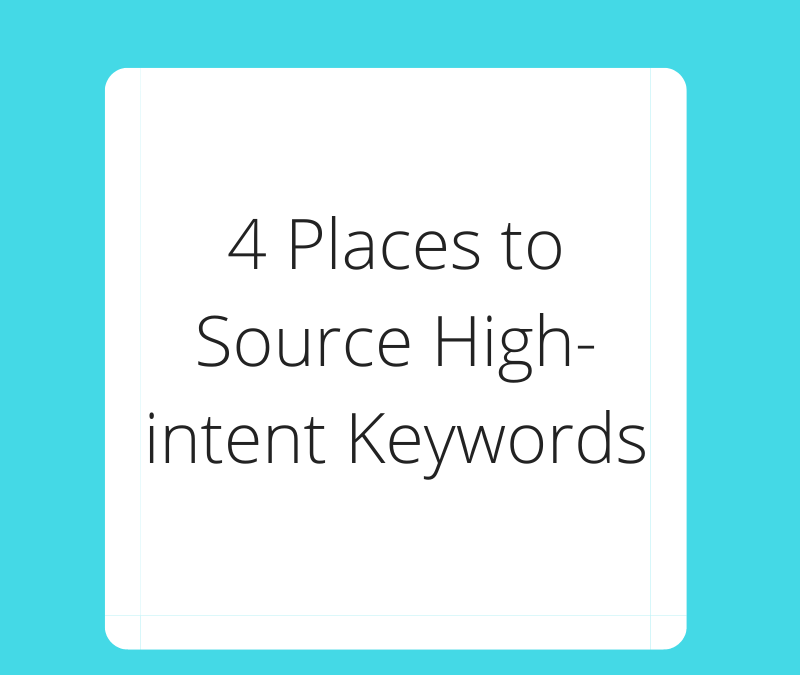Pay-per-click (PPC) campaigns are a quick and effective way to populate your lead pipeline, but they aren’t without their challenges. Not only do you have to contend with increased competition and higher costs-per-click (CPCs), but you also need to target the right keywords for your target audience.
Get it wrong and you risk spending money on low-quality leads without any intention of converting. But if you target high-intent keywords, you’ll see increased conversions and lower CPCs.
The trick is knowing how to find high-intent keywords that will drive the most success — you just need to know where to find them. Follow this guide to learn how to source high-intent keywords for paid ad campaigns.
Why Does Buyer Intent Matter?

Keyword phrases indicate where your shoppers’ heads are at. High-intent keywords indicate that a person is ready to take action; instead of simply looking for information, they’re ready to make a purchase.
As a business, it’s your job to determine the reason why someone is searching for information. Every search query has an intention behind it. If you want consumers to buy your products, you should choose keywords that indicate someone is ready to buy.
For example, if you search for “air filter change tutorial,” you probably need help changing an air filter; you likely have an air filter at this point and aren’t interested in buying one. But the phrase “20 x 20 x 1 air filter” suggests that you want to buy an air filter.
Not every keyword is worth your time and money. Since 68% of all web traffic comes from paid and organic search, you need to focus on high-intent keywords. If you’re plugging the wrong keywords into your campaigns, you risk missing out on potential leads.
You have to learn how to separate high-intent keywords from generic keyword lists to come out on top of the SERPs. This often includes search queries with phrases like:
- “Buy”
- “Order”
- “Enroll”
- “Discount”
- “Coupon”
The more specific you get, the higher the intent, and the higher the conversion rate. Since higher-quality leads have a better chance of converting, you’ll make better use of your team’s time and energy by targeting high-intent keywords.
By targeting high-intent keywords from the start, you can prevent lower-quality leads from entering your pipeline in the first place.
4 Surprising Places To Find High-intent Keywords

It’s time to ditch low-intent keywords. Source high-intent keywords from these four places to streamline your lead pipeline while boosting conversions.
1. Keyword Tools
Keyword tools can help you source high-intent keywords, but you’ll still need to do some legwork to decide which keyword ideas are actually high-intent.
Use tools like Ahrefs or SEMRush to discover new keywords. Drop in a seed keyword and the tool will spit out long-tail versions of that keyword. Since they include more detail, these keywords tend to have higher intent. You’ll still need to sift through them manually to pick the best options for your campaign.
2. Competitors
You should never copy your competitors’ keyword strategies, but it’s valuable to see which keywords they’re targeting. If you’re out of ideas, a little competitor recon can kickstart your PPC keyword research.
Use tools like Spyfu or Ahrefs to see which PPC keywords your competitors are targeting. This software isn’t 100% accurate, but it can help you brainstorm high-intent keywords you might not have considered otherwise.
3. “People Also Ask” on Google
This is a low-tech option, but it works beautifully. If you want to find high-intent keywords, open Google and enter your seed keyword. The search engine will suggest similar queries with higher search intent.
For example, if you enter the seed keyword “purple teddy bear,” you’ll see results like “what are purple teddy bears?” that aren’t high-intent. But you might see “buy purple teddy bear for Valentine’s Day,” which is a high-intent option.
4. Customer Feedback

Listen to your customers to source keywords with buyer intent. What phrases do they use? What questions do they ask? These are the same queries that your leads plug into search engines, so it’s worth diving into your buyer intent data.
You can find high-intent keywords by:
- Listening to sales call recordings or reading transcripts
- Interviewing your salespeople
- Viewing form submissions
- Accessing customer service chatbot logs
- Checking your online reviews and customer surveys
Patterns will start to emerge. For example, if you’re a beauty company, you might notice that customers ask, “Can I cover acne with CC cream?” That phrase is a perfect, high-intent keyword you can add to your campaign.
If you can add these keywords to your landing pages, that can boost conversions even more. Find customers’ burning questions, add them to your landing pages, and include them in your ad campaigns to source more leads.
Simplify Buyer Intent
High-intent keywords tend to be long-tail and less popular with your competitors, which should make them a shoo-in for your PPC campaigns. High-intent keywords aren’t always immediately obvious, but these four sources make keyword research a cinch:
- Keyword tools
- Competitor research
- “People Also Ask”
- Customer feedback
Need a little help plugging these keywords into your ad copy or website? Tap a pro writer like yours truly to see more results from your PPC campaigns.

